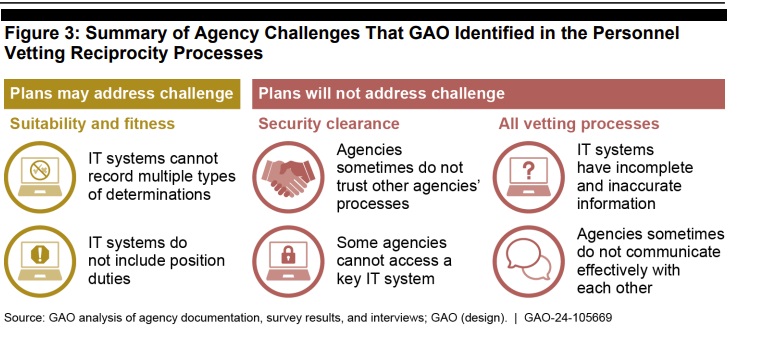Security clearance reciprocity or transfer of trust is an ongoing topic of security clearance reform efforts and the government’s Trusted Workforce 2.0 initiative. It’s one thing to obtain a security clearance, but in order to ensure workforce mobility and reduce costs and lengthy onboarding timeframes, being able to transfer clearance eligibility between agencies is key – and a frequent sore spot.
The personnel security process is on the Government Accountability Office (GAO) high risk list, and as such gets special attention in research and studies to analyze the process and specific pain points. A report released this week highlights actions needed to improve the transfer of security clearances. The report highlights the issues of inconsistent and incomplete data, along with the lack of a comprehensive IT system to track reciprocity and suitability decisions.
There are currently three IT systems used to track reciprocity/transfer of trust of personnel security clearances – the Central Verification System (CVS), the Defense Information System for Security (DISS), and Scattered Castles. The National Background Investigation Services (NBIS) is designed to consolidate all of these systems and enable more seamless transfer of trust. While it is doubtful that the IC would ever incorporate its data into a shared system, even for those under the DISS/NBIS umbrella NBIS has faced its own GAO critics and issues with cost and timelines. The GAO report on reciprocity notes that despite criticism of NBIS timelines in 2021 and the agreement of the Defense Counterintelligence and Security Agency (DCSA) that changes needed to be made, as of the report publication NBIS remained a system without a reliable schedule and cost estimates. The GAO recommended Congress requiring greater accountability for NBIS.
While NBIS is the low-hanging fruit to blame security clearance reciprocity woes on, GAO notes it’s not a silver bullet solution for every reciprocity struggle.
Security clearance reciprocity is an issue but so is suitability. ODNI officials acknowledged that agency personnel are typically making two reciprocity decisions – one for suitability and one for fitness.
Current plans within the government may address some of the suitability and fitness transfer of trust issues, but they won’t address other cultural, technological, and process barriers within both the security clearance and overall vetting process. Issues include the very real issue of many individual agencies and components simply not trusting the security clearance investigation conducted by another agency, as well as inaccurate or incomplete information in existing IT systems. Government stovepipes including within personnel vetting programs are a real issue – with many simply failing to do the basic work of picking up the phone to verify an investigation or information provided by a different agency and which could expedite a security clearance transfer. Of the 31 agencies GAO surveyed, 17 said they sometimes don’t trust the security clearance granted by another agency.
Despite Delays, Contractors Largely Satisfied with Reciprocity Process
While it’s clear there are delays and redundancies, a GAO survey of private contractors supporting the federal government found they were largely satisfied by the reciprocity process. 66 of 109 contractors were at least somewhat satisfied by the process. A key issue for all contractors, however, was a lack of communication concerning the status of reciprocity decisions and delays. The GAO found that 40 of 48 contractor respondents said agencies rarely or never provided information about reciprocity decisions.





